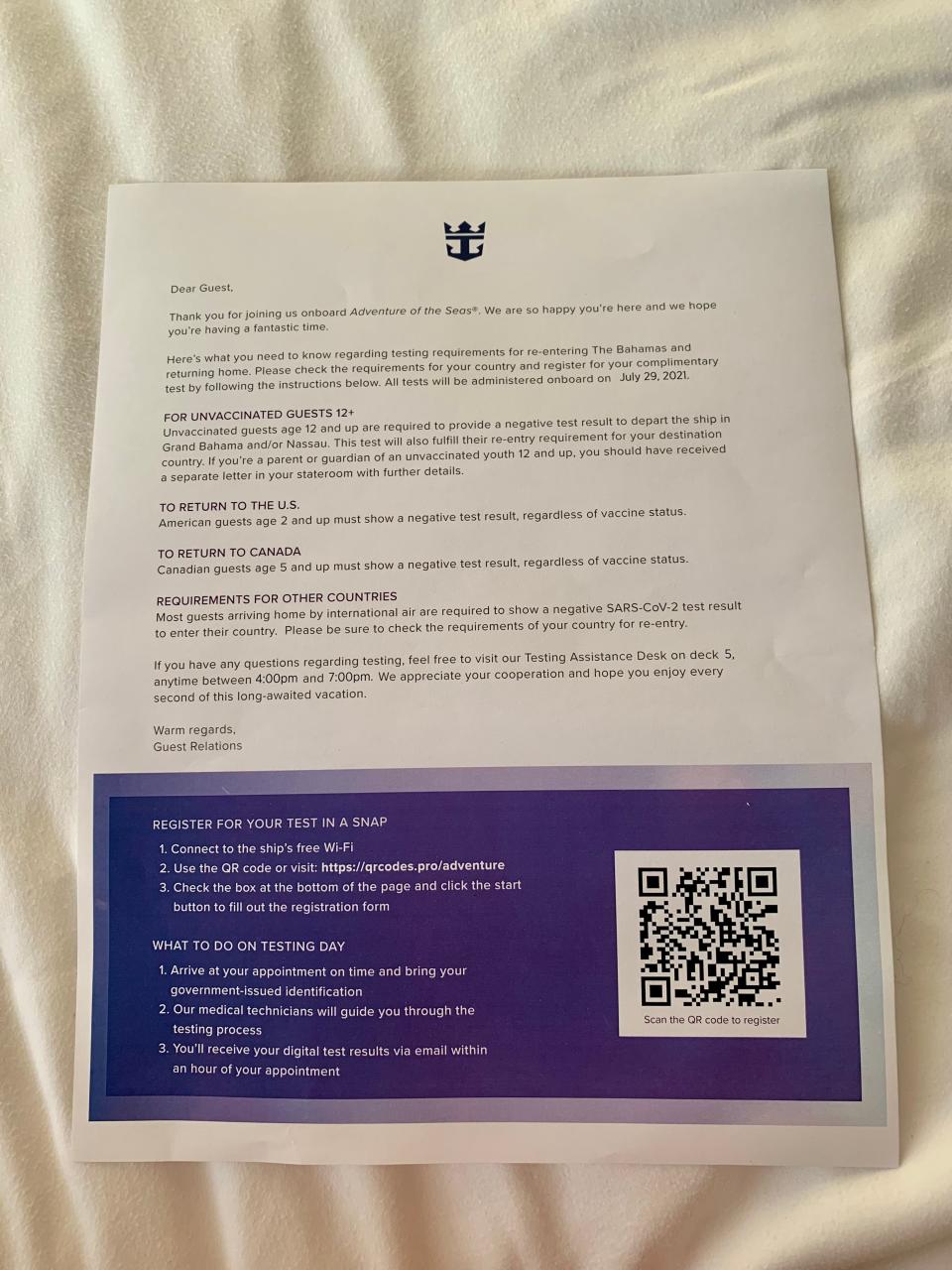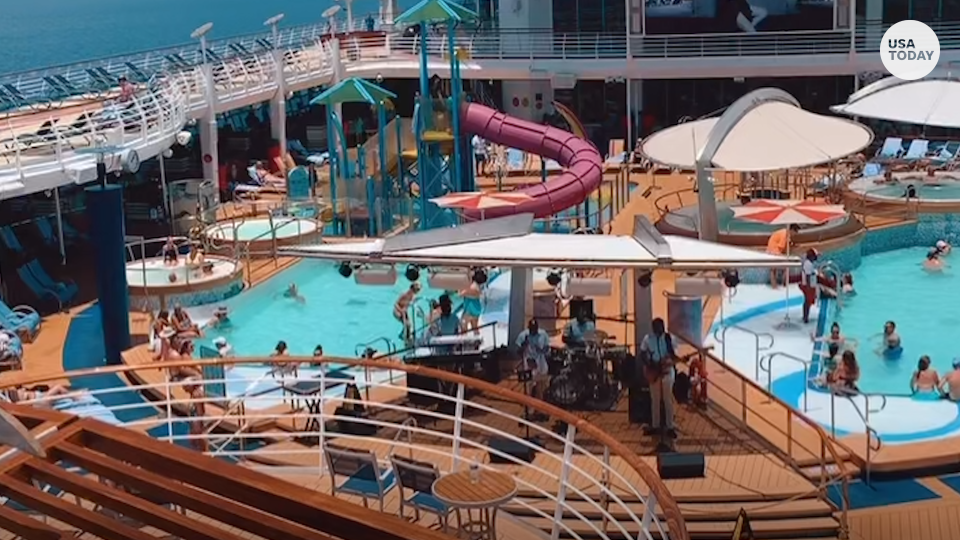'I felt safer on the cruise than Walmart': COVID protocols on cruises prove effective, initial CDC data shows
- Oops!Something went wrong.Please try again later.
The coronavirus continues to be present on cruise ships sailing in U.S. waters, data from the Centers for Disease Control and Prevention obtained by USA TODAY shows.
But travelers are feeling more secure with the protocols in place.
In the two-month period spanning from when the first cruise sailed with paying passengers on June 26 through Aug. 26, there were 452 confirmed cases of coronavirus on cruise ships reported by cruise lines to the health agency.
The cases reported were spread among crew and passengers who tested positive via viral testing on ships belonging to cruise lines including Carnival Cruise Line, Royal Caribbean International, Celebrity Cruises, Norwegian Cruise Line, MSC Cruises, Disney Cruise Line, Holland America Line and Princess Cruises, among others.
It doesn't come as a surprise that coronavirus found its way back onto cruise ships after more than a year without cruising in U.S. waters due to the pandemic.
"We've never said that cruising will be a zero-risk activity," Capt. Aimee Treffiletti, who leads the CDC's maritime unit, told USA TODAY in late October. "I think we've all always expected that cases would be identified."
►COVID on cruises: What happens if the coronavirus gets on board?
►Here's why I didn't panic: Six COVID-19 cases emerged on my Royal Caribbean cruise.
"Unlike other forms of travel, a cruise ship is more like congregate residential setting where thousands of travelers (passengers and crew) are living for multiple days (or months for crew) on the same ship: eating, sleeping, and participating in activities together in one location. COVID-19, like other illnesses, can spread quickly in group settings like cruise ships," Caitlin Shockey, spokesperson for the CDC, added in an email to USA TODAY.
But just because cases are emerging on cruise ships doesn't mean that cruising is as risky as it was at the beginning of the pandemic when outbreaks forced ships, including the Diamond Princess and Grand Princess, into quarantine with more than 700 infected on Diamond Princess and dozens infected on the Grand Princess.
COVID-19 protocols make ship environment safer
The protocol in place on ships to mitigate COVID-19 "absolutely has" worked to make cruise ships safer as the world faces a global pandemic, Treffiletti said.
While there still remains some risk of transmission of COVID-19 on board cruise ships, robust protocols including testing and masking, among other elements, have reduced the risk of the pandemic's onboard spread.
Alex Heller, who cruises frequently with his husband, Michael Bonham, on Royal Caribbean International ships, told USA TODAY they have been on five cruises since the pandemic began and have four more scheduled for this year.
Royal Caribbean International has required that all passengers ages 12 and over show proof of vaccination and a negative test for every passenger age 2 and older, a protocol which was put into place Aug. 1. As a result, Heller said they have felt safe.
"On one of the trips, we stayed a few nights in Florida after we disembarked," Heller said. "It felt like Florida had hardly any restrictions and a few people even approached us with snide remarks about wearing our masks, so we actually felt safer on the ship than we did on land."

Kathy Simmons, who sailed on the Carnival Magic in September, echoed Heller's statement.
"I felt safer on the cruise than Walmart," Simmons told USA TODAY. "I live in rural (Georgia) and next to no one masks or distances anymore."
Alex Winter added that he felt safer sailing on MSC Meraviglia this October than he did on a December 2019 Norwegian cruise thanks to additional protocols and lowered capacity.
As of Thursday, 52 cruise ships were sailing with paying passengers in U.S. waters following CDC guidance, according to the CDC's cruise ship status tracker, spokesperson Dave Daigle told USA TODAY.
"We've never expected that there would be zero risk of transmission," Treffiletti said. "But one thing that's really important is that we haven't seen medical resources overwhelmed on ships – we haven't seen high rates of hospitalizations or deaths that we saw early on in the pandemic related to cruise ships. So, I think we can consider that a success."
►Here's why I didn't panic: Six COVID-19 cases emerged on my Royal Caribbean cruise.
►A year without cruising: There was no ‘crystal ball’ to tell when sailing could restart amid COVID-19
What the data tells us
Cruise lines are required to report confirmed coronavirus cases and COVID-19-like symptoms reported on ships in U.S. waters to the CDC, but most cases of coronavirus on cruise ships have not been required to publicly report those numbers.
Crewmembers are also required to be tested on a weekly basis or at other intervals as required by the health agency after an initial testing requirement and testing of newly arriving crew.
Of the 452 cases confirmed, 146 were among crew members and 306 were among passengers. Fifty-seven ships reported COVID-19 data to the CDC within the two-month period, 11 of which reported no confirmed cases at all.
The CDC repeatedly told USA TODAY it does not have a count of how many people sailed on cruise ships in total during that period.
Story continues below.
Cruise Lines International Association, however, "conservatively" estimates 262,000 passengers sailed between June 26 and Aug. 26 on member cruise lines that sail on the ocean. The number does not include crew members, Bari Golin-Blaugrund, vice president of strategic communications, told USA TODAY.
The association's cruise lines make up more than 90% of ocean-going cruise capacity.
"The relatively low occurrence of COVID-19 during that period, particularly when compared to the rest of the country, further demonstrates the leadership of the cruise industry and the effectiveness of the science-backed protocols that have enabled a successful return to operations around the world," Golin-Blaugrund continued.
During the time that these 452 cases of coronavirus were identified on cruises, about 4.9 million cases were reported in the U.S. in the 62 days between June 26 and Aug. 26, CDC data show. With an American population of about 332.8 million, about 1 in 68 Americans tested positive during the same time when 452 cases of coronavirus were identified on cruises.
The ships that reported cases to the CDC were traveling under different circumstances: Some were sailing on test cruises (sailing with volunteer passengers to test onboard protocols to mitigate the spread of COVID-19); some were on restricted revenue sailings (with paying passengers); and some were sailing with crew only.
Cruise lines are required by the CDC to submit information on coronavirus cases in its "Enhanced Data Collection During COVID-19 Pandemic Form" as a part of its Conditional Sailing Order, originally introduced in October 2020 and extended last month.
Story continues below.
The CDC did not specify when over the two month period cases were identified, on what sailing the cases happened or the conditions of the sailing whether it be a test sailing, a sailing with paying passengers, or a sailing with crew only. This information is not asked for in the daily form required by the CDC, USA TODAY reviewed the form required by ships.
And the vessels that reported coronavirus cases to the CDC were sailing for varying amounts of time during the two-month period. Some cruise ships resumed operations earlier, others started at a later date in the industry's phased-in resumption.
People who tested positive during quarantine or upon embarkation were not counted as the CDC classified those cases as not contributing to the onboard spread.
It is not clear over how many sailings the cases were spread out, nor is it clear how many sailings each ship has completed and the duration of each sailing. Not all cruise ships in the U.S. are back in operation yet and it has been a rolling start with ships slowly resuming service.
There are many other variables at play too: Ship size, capacity filled, protocols, port stops and other factors could have contributed to coronavirus on board ships.
Cruise lines sharing coronavirus protocol results
Cruise companies have begun to share how their protocols have mitigated coronavirus on board as well.
During its third-quarter earnings call on Oct. 30, Royal Caribbean Group's chief financial officer Jason Liberty shared that out of 500,000 passengers who have sailed with the brand globally, only 150 have tested positive for coronavirus across the cruise company's five brands including Royal Caribbean International, Celebrity Cruises and Silversea Cruises along with TUI Cruises and Hapag-Lloyd Cruises. Those 500,000 passengers have sailed around the globe since June not just in U.S. waters, spokesperson Jonathon Fishman told USA TODAY.

Jessica John, spokesperson for Norwegian Cruise Line Holdings Ltd., parent company to Norwegian Cruise Line, Regent Seven Seas Cruises and Oceania Cruises, told USA TODAY that the company has identified positive cases on certain sailings since resuming operations but did not specify the exact count.
"Our rigorous SailSAFE health and safety protocols, including mandatory vaccination and universal pre-embarkation testing, are working as designed to greatly mitigate the risk of introduction and transmission of COVID-19 on board our ships and the prevalence of cases we have seen since resuming has been well below the general population during that time," John said.
Roger Frizzell, spokesperson for Carnival Corp., parent to Carnival Cruise Line, Princess Cruises, Holland America Line, Seabourn, AIDA, Costa Cruises and P&O Cruises, told USA TODAY that onboard protocols are working to mitigate the spread of coronavirus.
"When those rare situations occur when there has been variant cases for fully vaccinated guests, they are typically extremely mild and our protocols in place have been effective."
Coronavirus cases identified on board don't mean cruising is unsafe
While coronavirus is on board cruise ships, that doesn't mean cruising is stopping again any time soon or that travelers should be discouraged from boarding.
"Given the ongoing COVID-19 pandemic and development of variants of concern, including the delta variant, CDC has continued to collaborate with cruise ship operators to provide safe and healthy cruising environments for crew and passengers," CDC's Shockey said.
The CDC issued a "Level 3: High Level of COVID-19" notice warning on Aug. 20 for cruise travel that remains in place.
The number of cases shows that the coronavirus protocol implemented on ships is working.
"I was very impressed by their vaccine and testing requirements," Simmons said of her Carnival cruise. "I know things can still slip through the cracks, but knowing that all adults were vaccinated and everyone was tested prior to boarding gave me great peace of mind."
Heller, who prefers to cruise with Royal Caribbean International, said he "certainly wouldn’t feel safe" without the protocols in place.
If public health measures were not in place, Shockey said the CDC "would expect COVID-19 cases to increase on ships and potentially overwhelm their medical and public health resources."
►Cleaning a floating petri dish: How is a cruise ship sanitized after a coronavirus outbreak?
Contributing: Mike Stucka
This article originally appeared on USA TODAY: COVID protocols on cruises prove effective, initial CDC data shows

